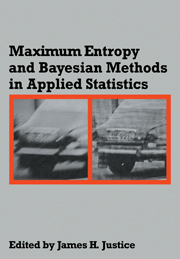 Maximum Entropy and Bayesian Methods in Applied Statistics
Maximum Entropy and Bayesian Methods in Applied Statistics Book contents
- Frontmatter
- Contents
- Preface
- Donors
- Bayesian Methods: General Background
- Monkeys, Kangaroos, and N
- The Theory and Practice of the Maximum Entropy Formalism
- Bayesian Non-Parametric Statistics
- Generalized Entropies and the Maximum Entropy Principle
- The Probability of a Probability
- Prior Probabilities Revisited
- Band Extensions, Maximum Entropy and the Permanence Principle
- Theory of Maximum Entropy Image Reconstruction
- The Cambridge Maximum Entropy Algorithm
- Maximum Entropy and the Moments Problem: Spectroscopic Applications
- Maximum-Entropy Spectrum from a Non-Extendable Autocorrelation Function
- Multichannel Maximum Entropy Spectral Analysis Using Least Squares Modelling
- Multichannel Relative-Entropy Spectrum Analysis
- Maximum Entropy and the Earth's Density
- Entropy and Some Inverse Problems in Exploration Seismology
- Principle of Maximum Entropy and Inverse Scattering Problems
- Index
Entropy and Some Inverse Problems in Exploration Seismology
Published online by Cambridge University Press: 04 May 2010
- Frontmatter
- Contents
- Preface
- Donors
- Bayesian Methods: General Background
- Monkeys, Kangaroos, and N
- The Theory and Practice of the Maximum Entropy Formalism
- Bayesian Non-Parametric Statistics
- Generalized Entropies and the Maximum Entropy Principle
- The Probability of a Probability
- Prior Probabilities Revisited
- Band Extensions, Maximum Entropy and the Permanence Principle
- Theory of Maximum Entropy Image Reconstruction
- The Cambridge Maximum Entropy Algorithm
- Maximum Entropy and the Moments Problem: Spectroscopic Applications
- Maximum-Entropy Spectrum from a Non-Extendable Autocorrelation Function
- Multichannel Maximum Entropy Spectral Analysis Using Least Squares Modelling
- Multichannel Relative-Entropy Spectrum Analysis
- Maximum Entropy and the Earth's Density
- Entropy and Some Inverse Problems in Exploration Seismology
- Principle of Maximum Entropy and Inverse Scattering Problems
- Index
Summary
INTRODUCTION
The ultimate problem in exploration seismology is the reconstruction by inference of the structure of portions of the earth's crust to depths of several tens of kilometers from seismic data recorded on the earthls surface. These measurements represent data obtained by recording the arrival of wave fields which are reflected back to the earth's surface due to variations in acoustic impedance within its interior. This data is complicated by multiple travel paths, conversion of wave modes (compressional or shear) at boundaries between homogeneous layers, and is corrupted by additive noise.
Over a long period of development, various procedures have been conceived which, when applied sequentially to seismic data, attempt to accurately reconstruct an earth model which most likely generated the observed data. This process is hampered not only by the complications mentioned above but also by the severely band-limited nature of seismic data (typically 5 to 100 Hz with most energy concentrated around 30 hz, for example) which introduces limitations on resolution, and difficulties in applying certain operators to the data in an attempt to improve resolution.
Most inverse procedures applied to seismic data today are deterministic procedures whose derivation is based on the “convolution model” to be introduced later. Recently, however, some new approaches to inversion of seismic data have been suggested. In contrast to previous methods devised for inverting data, these methods do not rely on operators applied directly to the data but rely instead on directly estimating an earth model which would generate data consistent with the observed data (which may still require some processing).
Information
- Type
- Chapter
- Information
- Maximum Entropy and Bayesian Methods in Applied StatisticsProceedings of the Fourth Maximum Entropy Workshop University of Calgary, 1984, pp. 269 - 299Publisher: Cambridge University PressPrint publication year: 1986